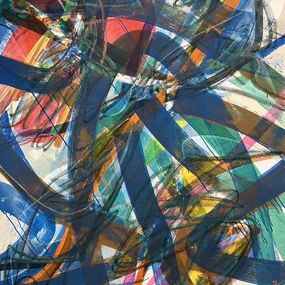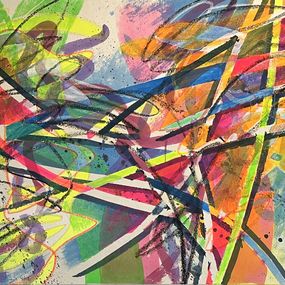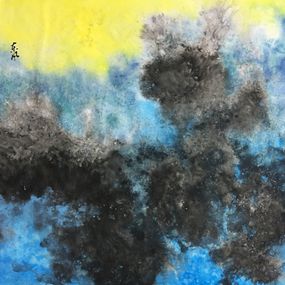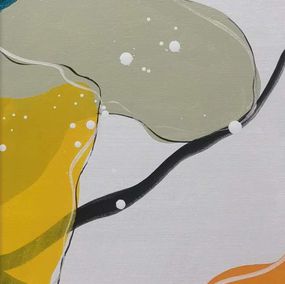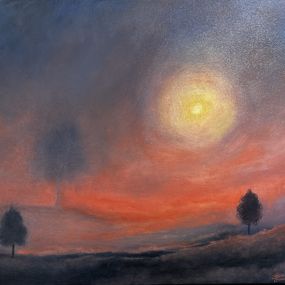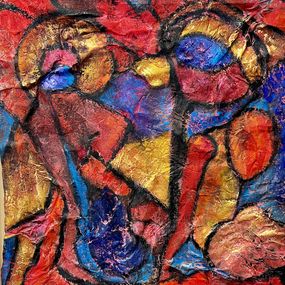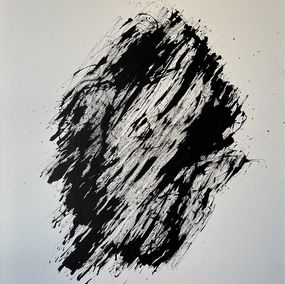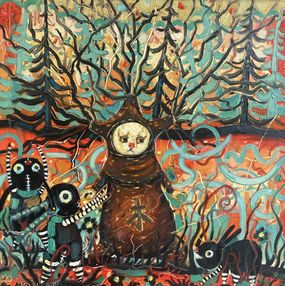
Sans titre 3,
2000
Hector Saunier
Painting : acrylic, mixed media
146 x 114 x 4 cm 57.5 x 44.9 x 1.6 inch
One of the last works available by this artist
Second NOT DISPLAYED BLUR TEXT
Free returns within 14 days
Authenticity guaranteed
Learn moreSecure payment
About the artwork
Type
Unique work
Signature
Hand-signed by artist
Authenticity
Sold with certificate of Authenticity from the gallery
Invoice from the gallery
Medium
Dimensions cm • inch
146 x 114 x 4 cm 57.5 x 44.9 x 1.6 inch Height x Width x Depth
Support
Framing
Not framed
About the seller
Galerie Feng Shang • France
Artsper seller since 2014
Vetted Seller
Top Seller
This seller rewards your purchases of multiple artworks
Imagine it at home
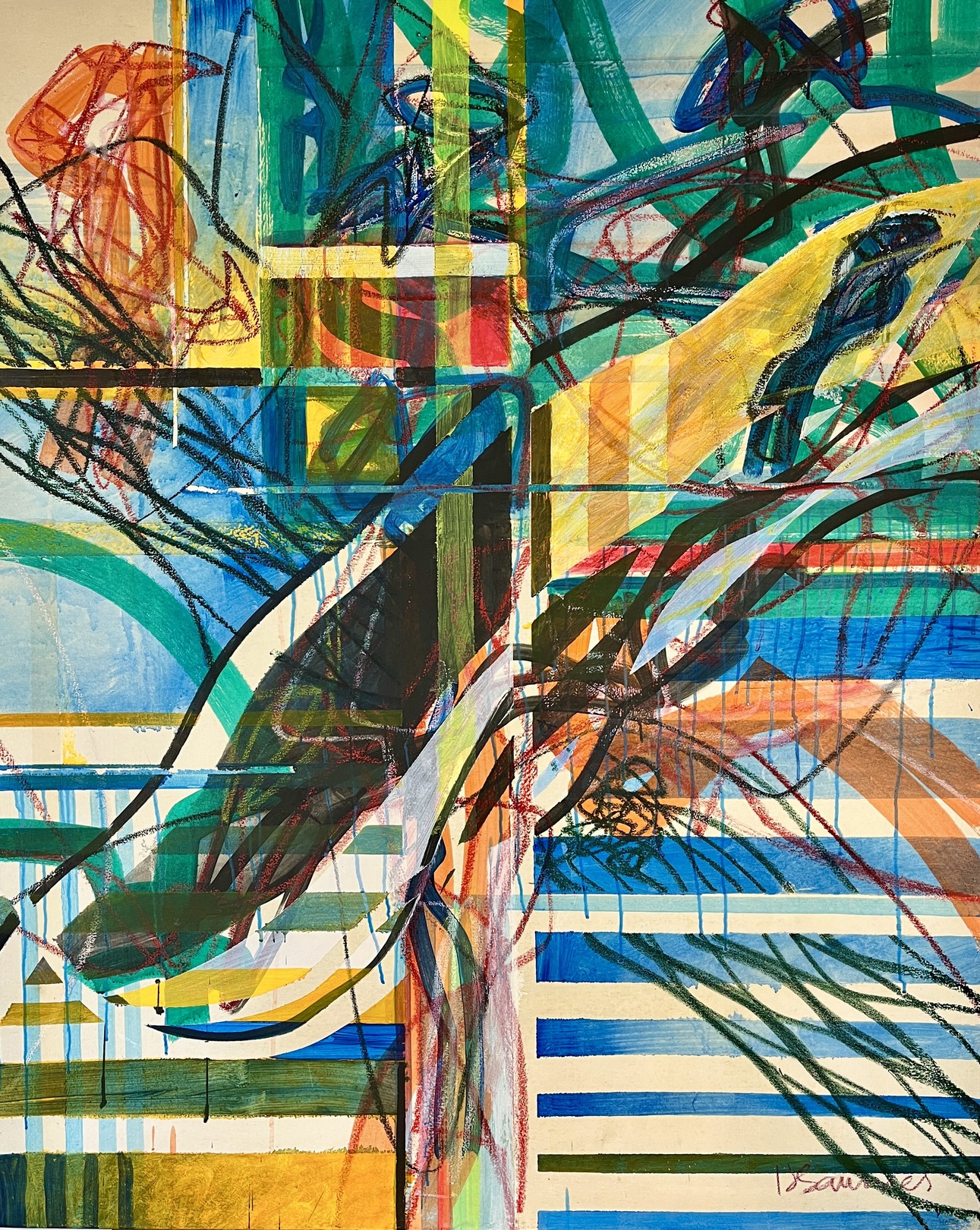
Discover more by the artist
Presentation
Born in Buenos Aires in 1936, Hector Saunier arrived in France at the age of 25 and made his career in Paris, where he died on February 25, 2024. A painter and engraver, a great traveler and a cultural melting pot, he was SW Hayter's assistant at Atelier 17, before becoming its associate director. He took over the studio after Hayter's death in 1988 and renamed it Contrepoint. His assistant Shulin Chen looks back on the work and technical prowess of a virtuoso of color engraving, always eager to share.
2Hector Saunier put down his chisel, stopped dreaming his colors, but he did not leave us alone, his work populates our places. With a perfect presence, his engravings will be able to defend themselves by themselves and do not require any of the explanations that he would not have given us anyway. He showed us the essential: a work is made in the moment and in time, by the force of the inscription and the perseverance of the beginning again, in the act and in the workshop. His self-confident hand, his leaning body, his enlightened gaze: a man entirely at work.
3Life is continuity, intelligence is rupture, art combines the two. Hector Saunier slipped into the rhythm of Atelier 17 in 1961, leaving behind the boredom that made him shake trees in Buenos Aires 1 . Europe attracted him as the primordial place of his family, of European origin, and as a source of the artistic culture that he wanted to deepen. He took over, becoming the right-hand man of the man who had brought him to engraving, Stanley William Hayter, then in 1988 he brought forth something new: the Contrepoint workshop, with Juan Valladares and then Shulin Chen. The strength of his predecessors carried him, gave him the place and the possibility to become an artist-engraver; in turn he invented and transmitted a place where others continue to become daring creators. A community of artists, amateurs or fervent practitioners, embodies the certainty that continuing the exploration of engraving, recording dreams or visions, giving body to images, is the most urgent and most important thing. Hector Saunier passed on the torch.
4At the Contrepoint workshop, we don't teach: we learn from others, from our own experiences, by getting hands-on, by trying to perfect the desired effects. Contrepoint, rarely has a name been more fortunately chosen for a workshop. It is music, among others that of JS Bach, which reveals a surprising resemblance with the way of working that we implement: transformation of the starting point, superposition of melodic elements to arrive at stronger and more intriguing effects.
5Hector has never stopped promoting and making engraving known through his numerous exhibitions around the world: England, Puerto Rico, Argentina, Japan, Morocco, Cuba, the United States... So many moments of discovery for spectators, but also so many links that brought artists or future artists from all these backgrounds to the studio. Someone had seen an exhibition, remembered, yielded to the temptation to cross the seas to join the studio: this was, and remains, the story of a certain number of artists full of hope and curiosity for this very living know-how. Why this force of attraction, what did he talk about to be so well understood? Hector said that the subject did not matter: "Do anything" he said to newcomers who asked him for advice. Of course, for a contemporary artist, these words are more classic than provocative. It should not be seen as an admission of indifference or frivolity. The subject is important, but not in its figurative, representative scope. It is the vine to which the color clings (), the ribbon that makes the embers visible (, Fig. 1), the expanse that supports the reflection (, Fig. 2). Nothing is less light than this desire for an undeniable presence, than this celebration of a life that never ceases to sparkle by launching lively, intelligently formed and colored images.
Hector Saunier was the great explorer of spatial effects. He seems to throw the chisel of which he is a virtuoso, inscribing the incisions in rhythm in the metal, superimposing a certain number of lines as for a musical score Lines and colours are juxtaposed, matched, and the traces are coloured. Hector Saunier's plates are the place where swirling lines wander, crossing and uncrossing with the freedom conferred by mastery of the tool and the power of inspiration. It is a question of not stopping the line, of giving it the power to bounce back, to start again, to get lost. No gaze will grasp it as a defined form, limited in its deployment. It goes beyond the sheet, suggests its acceleration and envelops us, it is it that seizes us. It is the detail of a space that is generated by the line, by the momentum that carries it. Depth, extension, movement, are as much produced as explored by the gesture of the hand that inscribes the chisel line on the plate.
7But what would momentum be without the trace? Presence without materiality? Dream without intrigue? It was necessary to seek and find the art of doing what was necessary. The technique developed over the years carries the desire for a precision that nothing anticipates but whose success is visible.
8He experiments with inking with a doll to obtain his effects with rollers of different materials, of different sizes, if possible covering the entire width of a plate in one go. He willingly exploits imperfections, such as perforated or deformed gelatin which adds a curious effect of imprecision. The rollers used for the passage of colored inks are sometimes soft, sometimes hard, sometimes have reliefs. He plays, by changing the quantity of oil in his inks, to cause "rejections". He ends up applying several colors at once on the same plate, obtaining incomparable moiré patterns. In a word: he allows himself liberties that become the trademark of his work. Printing itself becomes an act of creation instead of being part of the domain of reproduction. Yet, the prints are not monotypes. Repetition is perfectly possible, once the artist is satisfied with his "prototype". Hector aspires to reduce the number of passes on the press to just one to obtain his final proof, while expressing what is generally achieved with several plates and/or several passes.
9In this quest for a living and stable image, line and color understand and complement each other, without there being a winner. Each unfolds by favoring the other, dynamic or peaceful. They respond to each other as if to bring out a world that constantly nourishes the sensitive experience. The trace is not imitation, any more than color is, they are both emotional vehicles.
Hector particularly liked fluorescent colors, yellows, reds and blues. They blaze in and The harmony of colors is subtle, none dominates and the harmony is total. "The instrument that inspires me the most is the burin. I improvise directly on the copper "Colour, essential, is a completely different adventure," wrote Hector Saunier, thus summing up the dialogue that kept him engaged throughout his life as an enthusiastic and virtuoso artist.
1936 Born in Argentina
1956-60 Studied architecture and color theory at H. CARTIER Buenos Aires.
1961 He travels to Paris, studies and works at the Stanley 17 William Hayter studio
Personal Exhibitions
1965- Lloyd'Gallery London
1970- Le Haut-Pavé Gallery PARIS
Tippach Gallery, Goslar, Germany
1973- Museo des Grabado, Buenos-Aires Argentina
1974- Wildenstein Gallery Buenos Aires.
1975- Georgetown Graphics, Washington DC
York University, Toronto, Canada.
Rhode Island School of Design, Rhode Island, USA
1976- Gallery “M" Toronto Canada.
Daberkow Gallery Frankkfurt, Germany
Galetie Miyasaki Osaka Japan
Gallery "21" Tokyo, Japan
1977- Beni Gallery Kyoto Japan
1978- Galeria Rondanini ROME Italy
Altamira Gallery, Buenos Aires Argentina
1979- Off Gallery Nagoya Japan
Clark Saporo Gallery Japan
1980- Saint-Michel Gallery Luxembourg
Austral Gallery La Plata Argentina
Fontana Artis Gallery, Rosario, Argentina.
Zulema Zoireff Gallery, Mendoza, Argentina
Museo Municipal de Santa-Fé, Argentina
Eugenie Villien Gallery, Sao Paulo, Brazil
1981 Miyasaki Gallery, Osaka, Japan
Beni Gallery Kyoto Japan
Off Gallery, Nagoya, Japan
1982 River Gallery, Bordeaux France
1983 Galerie Nadar, Casablanca Morocco
1984 GalJeria Arte Contemporanea, Bari Italy
Hiramatsu Gallery, Osaka Japan
Ibsenhuet Gallery Skien Norway
Museum of Contemporary Art, F Alzate Avendano, Bogota Colombia
1985 Workshop 80, Bordeaux, France.
Eccentric, Liège, Belgium
Group Exhibitions
1968 Biennale di Pistoia Italy.
New Realities, Paris
1970 Paris Print Biennial
Bradford Biennial, England
Salon of Young Contemporary Engraving Paris
19th 20th Salon del Grabado, Madrid, Spain
1971 Epinal Biennale, France
Menton Biennale, France
1972 Contemporary Engraving Exhibition Pontoise, France.
1981-82-83-85-86
May Fair, Paris
1980-82-84-86
"Meetings", Sarcelles France
1983 Exhibition of the Museum of Latin America, Compiègne France
Puerto Rico Biennial.
1984 La Biennale dell'Avana Cuba
5th Condé Bondecour Biennale Belgium
1985 4 Artisti al Kunstforening Stavanger Norway
Collections
National Library of Paris France
Museum of the City of Paris France
Museum of Modern Art in Paris France
Public Library of New York USA
Museum of Quebec, Canada
National Museum of Istanbul Türkiye
Royal Library of Brussels Belgium
Museo del Grabado, Buenos Aires Argentina
Library of Congress; Washington USA
York University, Toronto Canada
Rosenwald Collection, Philadelphia USA
Caen Museum France
Asilah Museum Morocco
Museum of Grenoble, France
Ibsenhuset Skien, Norway
"Albertina" Vienna, Austria
More works from Galerie Feng Shang
This seller offers discount when you purchase multiple artworks!
Artsper delivers internationally. The list of countries is available in the first step of your cart.
If your country is not listed contact us at [email protected] and we will see what we can do.
Note that Customs fees may apply for works shipped internationally. This is indicated in the first step of the shopping cart.
You can choose a delivery address different from the billing address. Make sure that a trusted person is present to receive the work if you cannot be there.
Have you purchased a painting, sculpture or work on paper?
Find our expert advice for the conservation and promotion of your works in the articles below:
Artsper offers you access to more than 200,000 works of contemporary art from 2,000 partner galleries. Our team of experts carefully selects galleries to guarantee the quality and originality of the works.
You benefit from:
-
Works at gallery price
-
Return within 14 days, regardless of your location
-
Easy resale of the work purchased on Artsper
-
Personalized research tools (selection and tailor-made universe)
Our customer service is available for any assistance.
At Artsper, our mission is to allow you to collect works of art with complete peace of mind. Discover the protections we offer at every stage of your shopping experience.
Buy works from top galleries
We work in close collaboration with carefully selected art galleries. Each seller on Artsper is carefully examined and approved by our team, thus ensuring compliance with our code of ethics. You therefore have the assurance of purchasing authentic, high-quality works.
Total transparency: you know what you are buying
Before being posted online, all artwork on Artsper is reviewed and validated by our moderation team. You can browse with complete peace of mind, knowing that each piece meets our criteria of excellence.
Personalized support: our experts at your service
Our team of contemporary art experts is available by phone or email to answer all your questions. Whether you want advice on a work or a tailor-made selection to enrich your collection, we are here to support you.
Resell your works with ease
If you have purchased a work on Artsper and wish to resell it, we offer you a dedicated platform to relist it. To find out more, click here.
Make offers with Artsper: negotiate like in a gallery
You have the possibility to propose a price for certain works, just like in a gallery. This feature allows you to initiate discussions and potentially acquire your coins at advantageous prices.
Get help with your negotiations
Our team will negotiate for you and inform you as soon as the best offer is obtained. Do not hesitate to call on our expertise to ensure a transaction at the best price.
Order securely
Artsper satisfaction assurance
We want you to be completely satisfied with your purchase. If the work you receive is not to your liking, you have 14 days to return it free of charge, and you will be refunded in full, whatever the reason.
Secure payment with Artsper partners
All credit card payments are processed by Paybox, the world leader in payment solutions. Thanks to their strict security standards, you can transact with confidence.
Problem Support
In the rare event that an artwork arrives damaged or not as described, we are here to help. Whether for a return, refund, restoration or exchange, our team will support you throughout the process and will ensure that we find the solution best suited to your situation.
Conditions to benefit from Artsper protections:
-
Use one of the payment methods available on Artsper for your order.
-
Report any problems within one week of receiving the work.
-
Provide required photographic evidence (including original artwork and packaging).
Artsper guarantees cover the following cases:
-
The received work lacks a described characteristic (for example, a signature or frame).
-
The artwork has significant differences from its description (e.g. color variation).
-
The work is damaged upon receipt.
-
The work is lost or damaged by the carrier.
-
Delivery is significantly delayed.
With Artsper, you collect with complete peace of mind.






